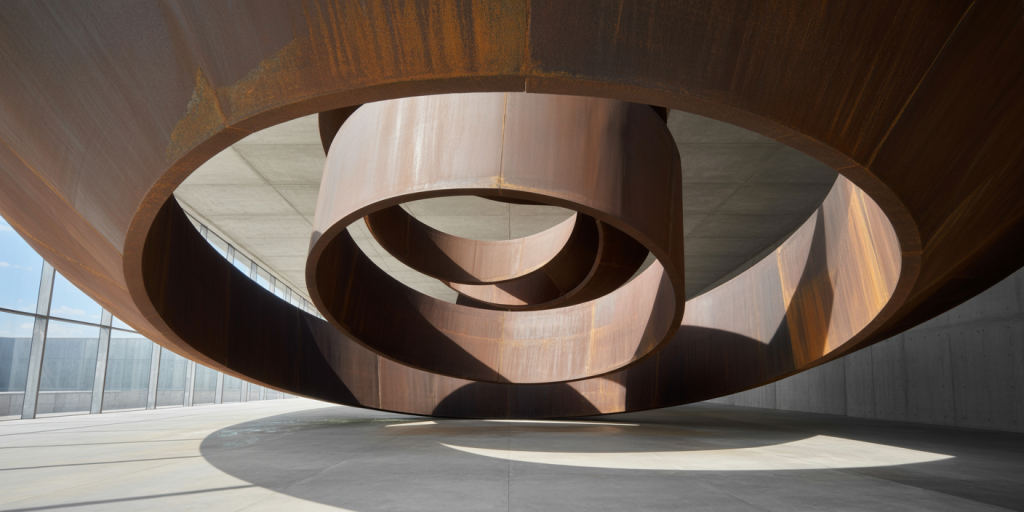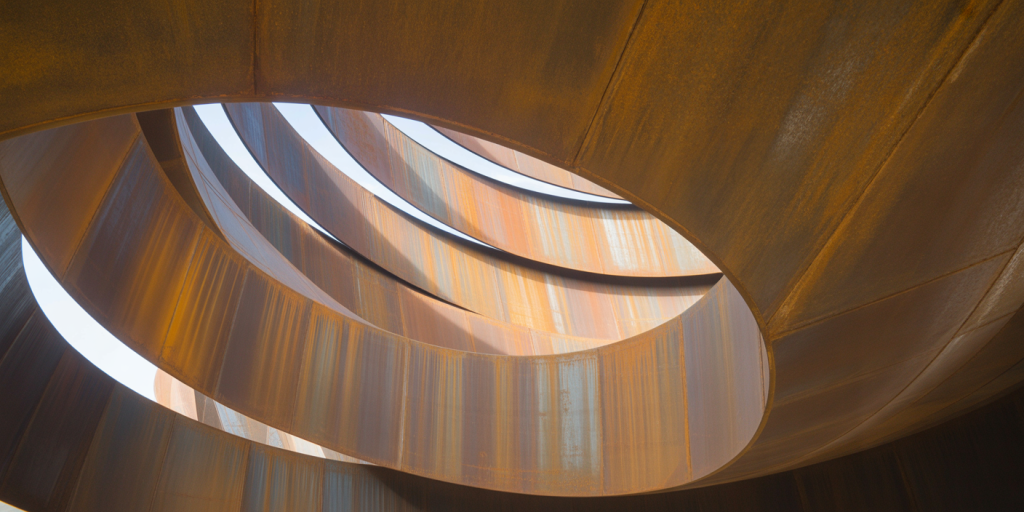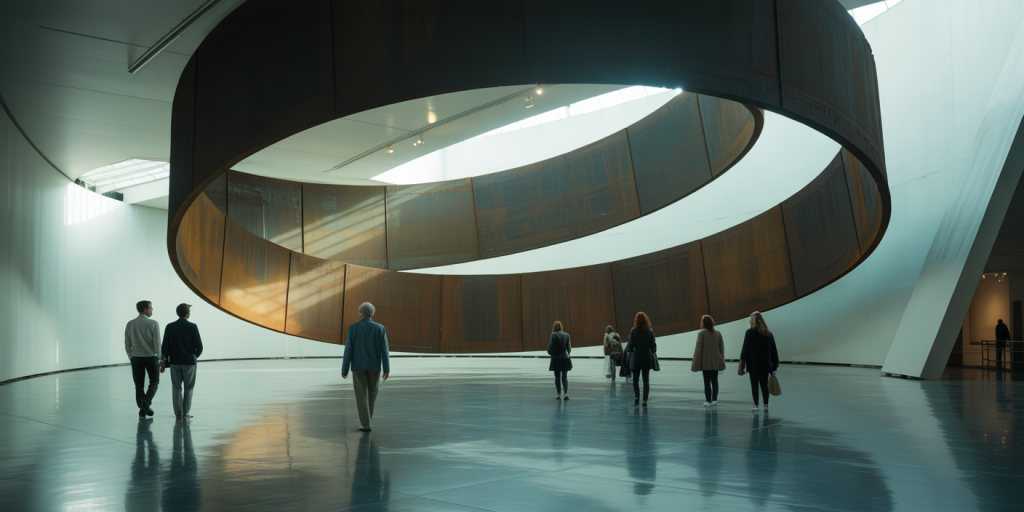Richard Serra’s Spirals and the Labyrinth of the Modern Soul
A Corridor of Gravity and Silence
One does not enter a Richard Serra sculpture; one is swallowed by it. There is no threshold, no clear invitation—only a rust-hued curve rising like a continental drift, carving space, swallowing light, bending sound. Walking into Serra’s spirals is like entering the lungs of the earth. You do not observe. You dissolve.
These vast weathered sheets of steel evoke something primal and pre-verbal. They do not speak in the language of symbols but in gravity and mass. Their surfaces whisper like thunderclouds. Their curves are not drawn by the hand, but by tectonic memory. To stand before them is to feel your own proportions questioned—your edges softened, your will turned inward.
Table of Contents
- A Path That Folds the Sky
- The Skin of Oxidation
- Walking the Wound
- The Echo of Rust
- Weight as Whisper
- Geometry That Breathes
- The Pulse of Empty Space
- Sentience of Steel
- A Maze Built from Memory
- Light That Breaks Like Thought
- Time Pressed Into Metal
- Surfaces That Remember Rain
- When Walls Begin to Sway
- The Labyrinth as Mirror
- Monumental Intimacy
- Fear in the Turning
- The Language of Silence
- The Vertical Shiver
- Presence Without Ornament
- The Soul as Spiral
A Path That Folds the Sky
Serra’s spirals do not merely curve—they enfold. They scoop the air into bowls of silence and shadow. As you move through them, the sky disappears and reappears in fractured slivers. Each step becomes a negotiation between disorientation and awe.
The movement is never linear. The walls guide and mislead, narrowing then opening like a breath. You are both body and sensor, navigating an architecture not of function, but of feeling.
The Skin of Oxidation
The surface of Serra’s steel carries the language of time. Oxidized, coarse, sometimes bleeding orange, it bears witness to weather and erosion. This skin is not finished. It is in flux.
Touch it, and you touch oxidation itself—the slow conversation between material and air. Rust becomes a memory etched in metal, a map of seasons pressed into surface.
Walking the Wound
To walk Serra’s spirals is to enter a wound. The steel walls rise like parted flesh, offering no ceiling, only vulnerability. You become the bloodstream in a massive, rusted body.
The sensation is at once sacred and surgical. You are enclosed, dissected from space. The labyrinth becomes an anatomy, and you, its pulse.

The Echo of Rust
Sound behaves differently inside Serra’s spirals. It does not bounce. It lingers, pools, folds. Your footsteps become part of the sculpture’s voice.
The echo is not hollow but heavy. It carries the same weight as the steel itself. Breathing becomes percussion. Silence becomes event.
Weight as Whisper
There is something paradoxical in Serra’s mass. Though towering and thick, the steel carries a whisper. It murmurs under light. It holds stillness like breath held just beneath the ribs.
The weight does not crush. It consoles. It reminds the body of its limits, and in that reminder, offers intimacy.
Geometry That Breathes
These spirals are not mechanical. They breathe. Their curves swell and contract. They follow the body like choreography. There is rhythm in the rust.
Geometry here is emotional. It is not measured but felt. You do not map these shapes—you surrender to them.
The Pulse of Empty Space
What defines Serra’s sculptures is not the steel, but the space between. That void becomes protagonist. You walk not through material, but through presence.
This emptiness pulses. It has rhythm and heat. It narrows to squeeze, then releases like forgiveness. In emptiness, you find encounter.
Sentience of Steel
Steel, in Serra’s hands, is not industrial. It is sentient. It holds memory. It remembers pressure. It greets you not as an object, but as another will.
This is not sculpture as decoration. It is sculpture as conversation. You are not looking at it. You are speaking with it.
A Maze Built from Memory
These spirals do not confuse like puzzles. They stir like flashbacks. They remind the body of mazes it has known before—hallways, corridors, childhood dreams.
The sense of familiarity is uncanny. You turn a corner and feel something remembered, though never lived. This is architecture as archetype.
Light That Breaks Like Thought
Light enters the spirals like an idea entering the mind. It strikes, bends, glides. At certain hours, it falls in lines like pages yet to be written.
This is not illumination. It is interruption. The light divides the steel into moods, moments. Time, too, spirals within.

Time Pressed Into Metal
Each panel in Serra’s work is a clock without hands. It contains time not as chronology, but as presence. The metal ages before you.
There is no urgency. Only duration. The kind that makes you breathe slower. Time becomes something your body walks through.
Surfaces That Remember Rain
You see the trace of rain along the steel’s face. Droplets leave streaks like calligraphy. Weather becomes collaborator.
These surfaces do not hide their story. They weep, they stain, they remember. Rain becomes ritual.
When Walls Begin to Sway
Though still, these walls seem to move. As you walk, the angles shift. The horizon tilts. The world stutters.
This is no illusion. It is the choreography of scale. The body adjusts, hesitates, reacts. Space becomes kinetic through perception.
The Labyrinth as Mirror
Each spiral becomes a psychological mirror. You enter thinking you observe the sculpture. But the sculpture reveals you.
Your fears, your wonder, your pacing. The path reflects your inner spiral. The labyrinth is not outside. It is you, made visible.
Monumental Intimacy
Despite their size, Serra’s spirals offer moments of closeness. A corner to pause. A narrow passage where your shoulder almost touches rust.
These are not fortresses. They are confessions in steel. They invite proximity, not protection.
Fear in the Turning
Some turns are sharp. Sudden. You are forced to pivot without warning. The space contracts. Your breath changes.
This is not aggression. It is honesty. The sculpture teaches alertness. You are awake in the spiral.

The Language of Silence
Serra’s sculptures do not shout. They do not instruct. They suggest.
Silence here is vocabulary. Each pause in the spiral is a comma in a sentence without end. You learn to listen with your spine.
The Vertical Shiver
Looking up inside a Serra spiral reveals a slit of sky—a wound of blue. That vertical line is a shiver.
It divides you. It lifts you. It anchors the entire mass in a celestial pause. The sculpture bows to the heavens.
Presence Without Ornament
There is no decoration here. No flourish. Only form and weight and shadow.
And yet, it is beautiful. Stripped of distraction, the raw becomes radiant. Presence is enough.
The Soul as Spiral
At last, you reach the center. Or perhaps there is no center. Perhaps you have been spiraling inward all along.
These sculptures are not places. They are states of being. The spiral is not a path through steel, but through self.
FAQ
Q: Who was Richard Serra?
A: Richard Serra (1938–2023) was an American sculptor renowned for his monumental works in weathered steel. His minimalist, site-specific installations challenge viewers’ perceptions of space and self.
Q: What materials did Serra use?
A: Serra predominantly used COR-TEN steel, which oxidizes over time, creating a rusted, earthy surface. The material choice reinforces themes of time, mass, and impermanence.
Q: Why does Serra use spirals in his sculptures?
A: The spiral form allows for a dynamic experience of space. It encourages movement, introspection, and transformation through the act of walking.
Q: Are Serra’s sculptures symbolic?
A: While not overtly symbolic, Serra’s work evokes powerful psychological and emotional responses. They are often interpreted as metaphors for inner journeys, time, and memory.
Q: Can you interact with Serra’s work?
A: Yes. Walking through the spirals is essential. The sculptures are designed to be experienced bodily—not just viewed, but inhabited.
Final Notes: The Weight of Presence
Richard Serra’s spirals are not simply objects. They are experiences. They require breath, patience, movement. They demand your whole being.
To enter one is to enter yourself—layer by layer, silence by silence. In steel, Serra gives shape to the labyrinth each of us carries. He does not tell us what it means. He makes us walk it.
